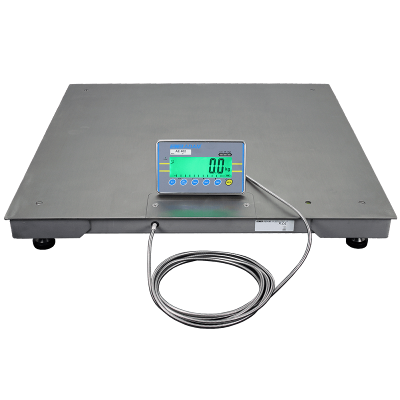
Platform scales can be found nearly anywhere: factories, shipping and receiving departments, mailrooms, warehouses and loading docks use them to weigh large, bulky or oversized items, including boxes, shipping crates, pallets, barrels, drums and luggage. In this post, we’ll walk you through one of the harder questions you may have to ask yourself: how do I choose the right platform scale?
Platform Scales
While you might think of platform scales only as larger scales that can handle 10,500 lbs./4,500kg like Adam Equipment’s PT platforms and Grade 304 PT stainless steel platforms, they also include smaller options that would be ideal for harsh industrial environments (like the IP68-rated W series of washdown platforms).
When choosing a scale, you know that you’ll need to consider capacity, readability and applications, but what other factors come into play with platform scales?

Weighing Indicators
Platform scales need to be paired with a weighing indicator, which can display weighing or counting results as well as perform a variety of other functions that your application might need. The indicator also allows the user to switch between applications and weighing units.
You can typically purchase an indicator as part of a package with a platform scale, but indicators are also available for purchase on their own if you choose to upgrade. An indicator with an integrated label printer, like the AE 504 or AE 503 makes it even easier to keep track of weighing results.
Size & Surface Construction
After capacity and readability, one of the most important considerations for a platform scale is the size of the actual platform and the platform’s construction. You wouldn’t want to try to weigh a pallet on an 11.8"x15.7"/300x400mm platform! While AELP pallet beams can adjust to weigh a wide variety of objects on a pallet, you’d generally want the objects you’re weighing to comfortably fit on the platform.
If you’ll be using the platform scale under messy conditions that require frequent cleaning, a washdown platform may be the right choice.
The old adage that you get what you pay for can certainly be true with platform scales. An inexpensive platform may be poorly made with bad welds or built from lower quality materials (i.e., a lesser grade stainless steel that will rust with frequent washing). Over time, inferior construction may result in the scale not being able to withstand repetitive weighing tasks and a higher cost to maintain.
A less expensive platform scale may have a thinner plate – that’s not necessarily a bad thing if it’s a lower capacity scale, but at higher capacities, the load could eventually damage the platform.
Are you weighing something that may get slippery or easily slide around? A diamond-plate surface would be better for traction – and safety – than brushed stainless steel.
Platform Scales & Ramps
Because the loads are often oversized and difficult to maneuver, one of the most helpful accessories for platforms scales are ramps. They allow heavy loads to be easily and safely wheeled onto a larger platform for weighing.
Adam’s ramps – which quickly attach to PT and PT stainless steel platforms – are constructed from durable mild steel or stainless steel.

For front-to-back or side-to-side loading, roller decks installed on a platform scale can also increase efficiency while making weighing tasks less strenuous for workers. Unlike conventional rollers, roller decks allow parcels to be easily moved across their surface in different orientations.
If you have any questions about platform scales or need some guidance on selecting the right one for you, ask us. We’re here to help!


